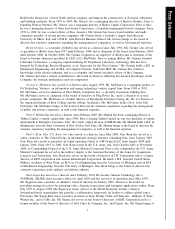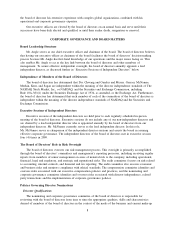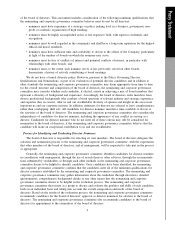iRobot 2009 Annual Report Download - page 19
Download and view the complete annual report
Please find page 19 of the 2009 iRobot annual report below. You can navigate through the pages in the report by either clicking on the pages listed below, or by using the keyword search tool below to find specific information within the annual report.
Proxy Statement
awards, performance goals for incentive compensation and equity awards for named executive officers, other
than Mr. Angle. In conjunction with the annual performance review of each named executive officer in January
of each year, the compensation committee carefully considers the recommendations of the chief executive
officer when setting base salary, bonus payments under the prior year’s incentive compensation plan, target
amounts and performance goals for the current year’s incentive compensation plan, and any other special
adjustments or bonuses. In addition, the compensation committee similarly determines equity incentive awards,
if any, for each named executive officer.
Our compensation plans are developed, in part, by utilizing publicly available compensation data and
subscription compensation survey data for national and regional companies in the technology, defense,
household durables and robotics industries. We believe that the practices of this group of companies provide
us with appropriate compensation benchmarks, because these companies have similar organizational structures
and tend to compete with us to attract executives and other employees. For benchmarking executive
compensation, we typically review the compensation data we have collected from the complete group of
companies, as well as a subset of the data from companies with revenues, numbers of employees and market
capitalizations similar to our profile.
With respect to 2009 base salary, cash incentive compensation, and long-term incentives, we reviewed
companies with similar-sized revenues of greater than $160 million and less than $630 million and market
capitalizations of between $70 million to $670 million, in particular: Aerovironment, Inc., Applied Signal
Technology, Argon ST, Inc., Audiovox Corp., Axsys Technologies, Inc., Ducommun Incorporated, Dynamics
Research Corp., Gencorp Inc., ICx Technologies, Inc., LoJack Corporation, Netezza Corp., Raven Industires
Inc., Tivo, Inc. and Universal Electronics Inc.
The compensation committee engaged a consultant, DolmatConnell & Partners, to help evaluate peer
companies for cash compensation and long-term incentive purposes, analyze applicable compensation data and
determine appropriate compensation levels for our named executive officers. In addition, we engaged a
consultant, Wilson Group, to assist in development of our performance incentive plan, which is the cash
incentive program that applies to all employees at the manager level and above. Certain elements of the
performance incentive plan, including identification of a limited number of key financial metrics as elements
of incentive cash, balancing corporate and divisional priorities, are consistent between compensation policies
adopted for executive officers and other managerial employees.
We will annually reassess the relevance of our peer group and make changes when judged appropriate.
We believe that the use of benchmarking is an important factor in remaining competitive with our peers and
furthering our objective of attracting, motivating and retaining highly qualified personnel.
The compensation committee reviews all components of compensation for named executive officers. In
accordance with its charter, the compensation committee also, among other responsibilities, administers our
incentive compensation plan, and reviews and makes recommendations to management on company-wide
compensation programs and practices. In setting compensation levels for our executive officers in fiscal 2009,
the compensation committee considered many factors in addition to benchmarking described above, including,
but not limited to:
• the scope and strategic impact of the executive officer’s responsibilities,
• our past business and segment performance and future expectations,
• our long-term goals and strategies,
• the performance and experience of each individual,
• past salary levels of each individual and of the named executive officers as a group,
• relative levels of pay among the executive officers,
• the amount of base salary in the context of the executive officer’s total compensation and other
benefits,
• for each named executive officer, other than the chief executive officer, the evaluations and recommen-
dations of the chief executive officer, and
17
























